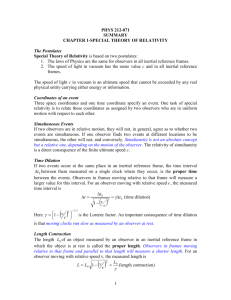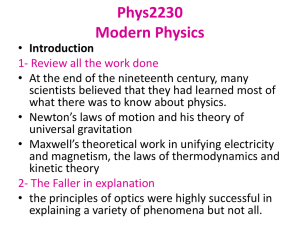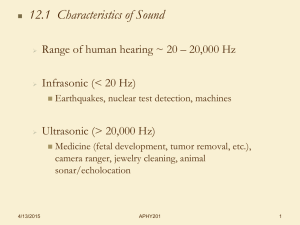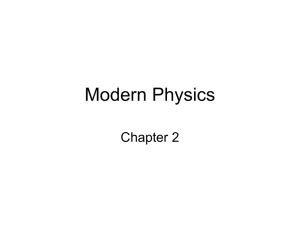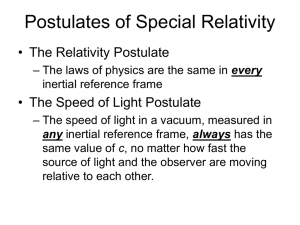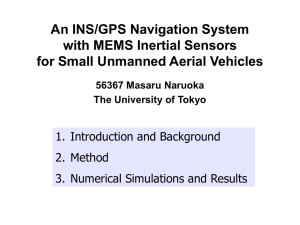On Inertial Paths, Frames and Groups
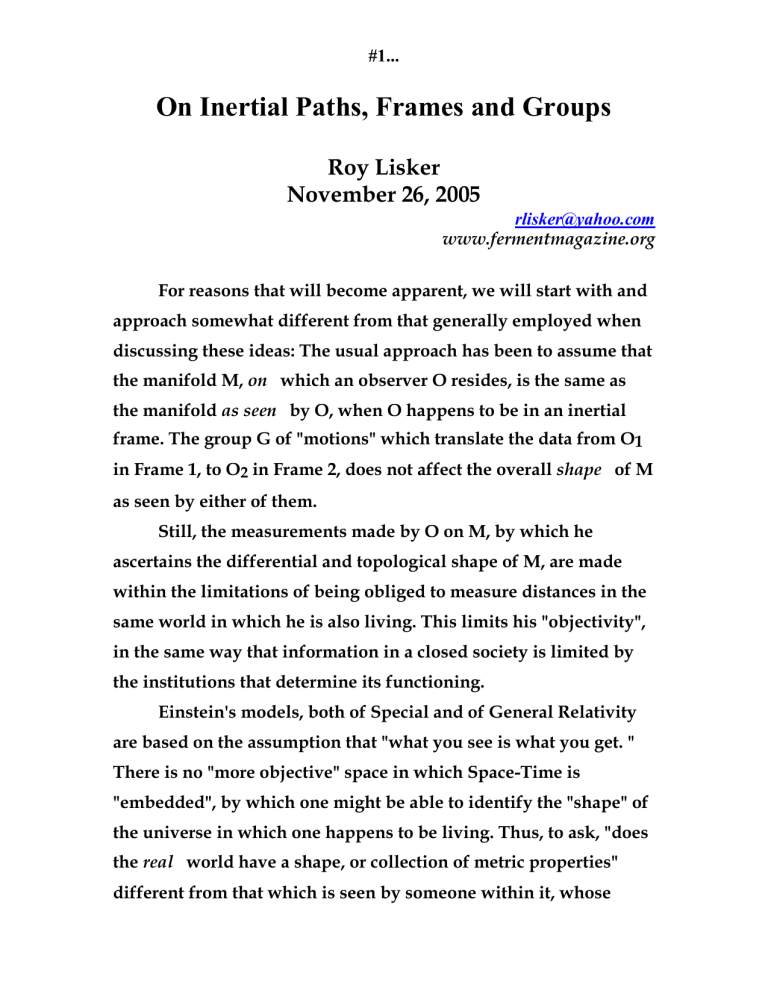
#1...
On Inertial Paths, Frames and Groups
Roy Lisker
November 26, 2005
rlisker@yahoo.com
www.fermentmagazine.org
For reasons that will become apparent, we will start with and approach somewhat different from that generally employed when discussing these ideas: The usual approach has been to assume that the manifold M, on which an observer O resides, is the same as the manifold as seen by O, when O happens to be in an inertial frame. The group G of "motions" which translate the data from O
1 in Frame 1, to O
2
in Frame 2, does not affect the overall shape of M as seen by either of them.
Still, the measurements made by O on M, by which he ascertains the differential and topological shape of M, are made within the limitations of being obliged to measure distances in the same world in which he is also living. This limits his "objectivity", in the same way that information in a closed society is limited by the institutions that determine its functioning.
Einstein's models, both of Special and of General Relativity are based on the assumption that "what you see is what you get. "
There is no "more objective" space in which Space-Time is
"embedded", by which one might be able to identify the "shape" of the universe in which one happens to be living. Thus, to ask, "does the real world have a shape, or collection of metric properties" different from that which is seen by someone within it, whose
#2...
measurements are bound by its constraints, is to ask a question without meaning.
We begin with a somewhat different approach. Let M be a
Space-Time manifold entirely embedded within a manifold of greater dimensions. For the examples discussed in this paper, we let M have dimension n, and N dimension n+1. Assume that, in some sense, (which must be justified anew with each situation), N is "non-relativistic". Its' inertial group is Galilean and its time dimension absolute. There is no upper limit to velocities, their composition is additive, and in theory, distances can be measured instantaneously, so that a concept of simultaneity may be defined.
Within N there are 2 kinds of embedded manifold:
(1) "Moving manifolds" M. These do not change their shape from time t1 to t2, but do continuously change their position inside
M. The paradigm one has in mind is that of a 2-sphere twirling about an axis in 3-space, or one moving in any sort of erratic pattern.
M in other words, moves through N as a rigid body, subject to the continuous actions of translations and orthogonal rotations.
Time on M works exactly as it does in all of N, but space is determined by distance measurements made entirely on the surface of M and its intrinsic coordinates. These can, but need not be, geodesic coordinates determined by the embedding in N.
(2) "Stationary relativistic manifolds ". These manifolds are at rest in N. However, the time dimension is acted upon by a non-
Galilean inertial group . Frames F
1 and F
2
which see themselves at rest but each other as moving, are both seen as moving in N; or
#3...
one of them is seen at rest. However, N has no way of informing observers O
1 and O
2 of their absolute motion. Therefore, there is no absolute motion and that a certain reference frame is seen to be at rest from the standpoint of N is irrelevant. "Residents" of N can "talk about" what's happening on M, but can't influence anything going on there.
(3) "Relativistic manifolds in motion ". These combine the properties of the first two classes of manifolds.
One is interested primarily in topological considerations.
Are there situations in which observers in N or on M describe different topological configurations, so that for example, N sees M as simply connected, whereas an observer on M will claim that it has holes, or singularities, a boundary, etc.?
Example 1: N has dimensions, (x, y, t) two spatial and one temporal. M is a stationary circle, centered conveniently at an origin in N. The dynamics on M, though free in most respects, are limited by a cyclic time dimension. That is to say, all systems must function as clocks, returning to their initial state after a time T.
Let p be some reference point on M, moving under some periodic force
. In terms of N's coordinate system, the graph of p(t) will be some periodic shape of period T.
#4...
p
M
N
If the time dimensions on M were that of N, uniform circular motion as seen by N would become uniform linear motion on M.
What about inertial frames? If p and q are moving apart at velocities u and v respectively, each would see the other as flying away at a velocity u-v. Inertial frames would be Galilean, save that distance is modulo C, C being the circumference of the circle.
However, what happens when time is modulo T? In that case, certain "inertial motions" which appear natural to N, would be impossible when seen on M. The only permissable velocities are v = T/C , 2v , 3v ,...... Spacetime is no longer continuous, but everywhere disconnected . This means that intervals of time I which are not of the form I = rT, where r is some rational number, cannot be measured. In some sense they don't exist. This is because the pendulums on all clocks must have periods T, T/2, T/3 , and only intervals of the form k(T/n) can be measured by them. In some sense the "non-rational" durations don't exist.
One might perhaps imagine the possibility of constructing clocks that pulse at some arbitrary time duration t <T , then just
"go haywire" at a certain moment, to come back to their initial state
#5...
in time T. But this is contrary to the notion of an ideal clock, which pulsates in exactly identical intervals of time because it always returns to its initial state in that time. A system that capriciously goes off into a new state is either not a clock, or the identification of an initial state has been incorrectly made.
Example 2:
Let S be a sphere of radius R ( conveniently set equal to unity
) and stationary in N. "A" is an observer situated at a location on S.
A sees himself as being "at rest" : he can detect no local physical effects that signify the presence of motion. We will discuss what theses effects might be in a moment.
C is another location on S, and E is the geodesic or "equator" connecting them. Imagine that A has determined that C is moving away from him with velocity v. Then, all things being equal, C concludes that A is moving away from him at velocity -v.
Now let B be situated between the North Pole and the equator at a point on the perpendicular to E passing through C, and that B always perceives C to be at rest. The location of B is at some angular distance r <1/2 as measured from the North Pole.
How will A perceive B? Still A sees C as moving at velocity v,
C will complete a rotation in time = 2 /v . B will seem, to A, to complete a rotation in the same length of time. However, the circumference of the (non-geodesic) circle through which B rotates, will be d= 2 sinr. The "velocity" of B will then not be v, but w = 2 sinr/(2 /v) = vsinr ,
#6...
which is < v. Furthermore, the circle along which B is seen to move is no longer a geodesic.
Otherwise stated, the fact that C perceives B to be at rest does not mean that B is in its own reference frame. There is, therefore, an objective way to determine ones own motion. Although it is moving at speed v, the curvature at C will be 1/R 2 , But when B measures his curvature, he gets the number 1/Rr . Since B and C see each other as being at rest, C discovers that it is moving at a velocity v, and that B is keeping in step in a parallel, but not a geodesic, path.
Thus, two observers , C and B, who see themselves as being at rest in the same reference frame , will be seen differently by A.
Example 3:
Now S is a sphere embedded in N, spinning counterclockwise around an axis with uniform angular velocity .
Ignoring the effects predicted by General Relativity, any observer
A on the equator of S will see himself as being at rest.
What does this mean?
(1) All objects within his field of perception will retain their distances from A when measured by a ruler laid down from A
(2) Time operates under the same group in M as it does in N. Hence, there will be no time-related effects on M different from those in N
Let B be a point off the equator, Let 1 be the radius of the sphere, and D <1 be the distance of B from the North Pole. Then B will "know that he is in motion", through the Coriolis effect. That is to say, there is a physical effect that can be measured at B that
#7...
will indicate to him that some sort of force is acting on the universe
S.
Example 4:
A "quantum mechanical wave-space" acted on by the
Lorentz group:
We will construct a quantum space E of wave fronts, which allows for the construction of clocks of all periods, provided that these periods are larger than a certain minimum frequency, T.
The quantum relations for Energy and Momentum are
E = h
= h/
As h is a universal constant and frequency is the period of a wave, (hence with dimension t -1 ) one observes that energy, like velocity, also varies inversely as the time. Let us therefore restrict our dynamical systems to sheaves of wave-fronts being propagated along an x-axis, all of which have the same wave-length L. Then the
"wave momentum" will be a constant. Since:
E/ = h v|= s , v velocity, s = speed , it follows that
E = (h ) v = cv, where c is a constant. Therefore, in this universe, the wave-energy varies directly as the magnitude of the velocity, or
speed.
Each wave-front with a fixed v may be considered an inertial frame.
The "observations" of a "observer' moving on a wave can be understood by imagining the waves as trajectories wrapping about a cylinder. In another paper it is shown that the cylinder admits a
#8...
Galilean group of inertial frames. Thus, an observer moving along
"on" the base space (projection of the wave quantity to the space of the dependent variable x) of a Schrödinger wave of energy E, or velocity E/c , will "see" a wave of velocity u with energy E' as having energy E'-E .
In the same paper it is shown that a cylindrical spacetime cannot admit a Lorentzian structure of inertial frames.
Each wave front, in addition to being a reference frame, can also be treated as a clock. If W
1 has period T
1
, W2 has period
T
2
, then we can calculated the period of the composition W1 (+)
W2. This is not a linear composition law. If one wishes energy to be additive, the law for the composition of periods will not be linear.
Indeed:
E
3
3
E
1
1
3
3
E
2
1
1
1
2
2
h
2
3
h
1
1
1
h
1
2
2
;
From this one can see that, when two quantities of energy are added, the resultant period is less than either of the two initial periods.
Let us return to the model of a spacetime M embedded inside a Galilean spacetime N of higher dimension. M may be stationary or moving. M could be for example a torus, or a rotating torus. An observer on M may not even "see" the same manifold that N sees,
#9...
and it may be the case that causal interraction between N and M is not possible, so that N cannot communicate to M what he sees.
In developing the concept of a rest frame F for an observers
O,A,B, C, in M the following conditions would appear to be obligatory
I. A rest frame is an equivalence class:
(a) If A is in the rest frame F of B, then A;s rest frame is F.
(b) A is in the rest frame of B, and B is in the rest frame of C, then A is in the rest frame of C
(c) All members of the same rest frame F "see" the same manifold M
II. Rest frames are preserved under inertial motions :
What this means is this: If A , in frame F, observes that B is in a different reference frame G, and B sees that C is in the same frame as itself, then A will also see that C is in G.
Once again, if A is an observer on a sphere S, in uniform motion along a geodesic, then A observes only the observers B along that geodesic as moving on inertial paths. If B sees another observer C, off this geodesic, as being at rest, A will not see C as moving along an inertial path, but some other path. There are no rest frames on a sphere.
C
A
B
#10...
III. The Cosmological Principle : Rest frames are homogeneous and isotropic.
Homogeneity ( Invariance under translations ) :If A and B are in the same rest frame F on M, then their perceptions of F and M are indistinguishable: M looks the same from every location in the same reference frame F.
Isotropy: Rest frames are invariant under rotations. They look the same at every location from all directions.
This definition runs into some difficulties when dealing with the surface of a cone. If A and B are locations on a cone, such that B is further away from the vertex than A, then although the "world" looks the same to A and B, the metric used at A must be changed when translated to the metric at B. Otherwise the distance to the vertex from B will contain more "units" than the distance to the vertex from A.
At the same time, the cone surface is "flat": within restricted regions of the surface the dynamics are Galilean. Galilean transformations are congruences, conic transformations are similarities.
Therefore the definition of homogeneity, as pointed out by
Einstein, requires that one specify the way in which the metric changes in going from A to B.
Of course the cone is not isotropic: the world along a line going to the vertex is very different from the world at right angles to that line
#11...
Detecting one's own motion
The idea, frequently expressed in discussions of relativity , that "O cannot make any experiment" in M to "detect its own motion" 1 . What this really means is that a list of criteria must be drawn up which allows O to decide that it "is" moving, or " is not moving".
One example of such a criterion is a "Coriolis force". Since the earth is spinning about its axis, a pendulum swinging along a longitudinal geodesic will be deflected by a "force" proportional to the angular velocity of the spin, and inversely proportional to the sin the angle of declination from the North Pole. (Verify this ). This is not really the same as the "gravitational force" of General
Relativity. What it is telling us in fact, is that the apparent curvature of the Earth is altered by its rotation.
Therefore, if a standard triangle is drawn around an observer on M, and the sum of the angles of that triangle is seen to change
(without any alterations in the lengths) , this may be taken as an indication that the observer is in motion.
Another indicator is an unexplained tension or friction. Once again, let S be a sphere at rest. The "inertial uniform velocity" of an observer O on S would be movement along a great circle. If O is constrained to move along a circle centered on the North Pole which is not a geodesic, it can only be because O is prevented from moving along a great circle by some kind of tether or force , without which it would naturally move on a great circle. One can
1 O is clearly an "it" given its lack of gender.
#12...
restate the above as follows: The great circles are the integral curves of the "Killing field" of the sphere. Pointing an observer O at a location L in a given direction is equivalent to the action of an element of the Lie Algebra at L. This completely determines the trajectory of the observer.
Motion against the gradients of the Killing field is resisted by a force that would be experienced in the form of friction, that is to say, heat, or tension, which can be looked upon as some kind of
"gravitational force" as interpreted by General Relativity.
Another indicator of motion would be an unexplained movement of something which, by convention, is taken as a fixed
star . For example, if the manifold M is a cone surface, one could argue that its vertex is immovable. If the entire cone M moves through the space N, an observer on M would detect no movement of the vertex.
Therefore, if the vertex is observed to move, O can plausibly argue that this is indirect evidence for its own motion.
Therefore the following 4 criteria will be taken as
"experimental tests" that an observer O might make to detect its
own motion :
(1) Changes in the curvature of a standard triangle centered on O. This can be translated into a measurement of the sum of the angles of that triangle
(2) Friction. An unexplained source of heat, or variation in heat , indicating a tethering force
(3) Tension. By the principle of equivalence this can be equated to a gravitational force.
#13...
(4) Motion of one or more of the "fixed stars". The cone vertex can be generalized to any set of singularities on M which cannot partake of relative motion.
The following situation sums up the concepts of rest frame, inertial frame and inertial group. It is somewhat strange, in that it is couched in language that appears to depend upon subjective opinion. In the following discussion the 4 criteria stated above will substitute for "objectivity":
The dynamics of a spacetime manifold M, will be called
inertial if whenever:
(1) Observers A and B determine themselves to be at rest, that is, they cannot detect their own motion; but
(2) A observes B to move at uniform velocity v. Then
(3) B will observe A to move at uniform velocity -v , and
(4) A (B) will observe B (A) to move along a geodesic.
Inertial Frames and Metrizable Time
In Minkowski space, there is a natural metric uniting space and time. There is no such unification in Galilean relativity.
However, although time does not enter into the metric, time is
metrizable .
Imagine a universe which, spatially, has all the attributes of
Euclidean geometry, but in which it would not be possible to
construct a clock . What implications can one draw from this?
The construction of clocks requires many things:
#14...
(1) At any specified location (x,y,z) there must be a way to determine the passage of equal intervals of time. This is very easy for spatial measurement once one has a ruler in hand, but is not easily defined for a dimension which does not allow for reversals. Though I know that the passage from 4 to 5 o'clock is real, because I experience it, the reverse passage, from 5 to 4, is a total abstraction, since, (barring wormholes and Godel spaces), it is not an object of experience, the minimal requirement for scientific knowledge.
Why, then, do we say that the length of a day is approximately the same from one day to the next? It certainly isn't exactly the same, but the approximation is good enough, at least in a small portion of the year. We deem years themselves, with more justice, to be essentially identical in length. although we know that this isn't exactly so. Why do we do this.
We use days, months, years, sand hour -glasses, pendulum clocks and caesium atoms to measure "equal" units of time, because they all return to the same initial state, S, combining a physical location ( or indistinguishable physical location) with a set of dynamic laws that cause it to pursue a nearly identical trajectory
with each return to that initial state.
A universe which does not have any system of this sort is governed by a time dimension that is not metrizable . The phrase
"indistinguishable physical location" has been included in the above to handle the case of uniform motion or fixed velocity. If an object moves in a straight line from point U to point V and, all things being equal, the dynamical state is unchanged, ( relations of
#15...
energy, force, etc.) we assume that when the distance from W to V is the same as from V to U, then the passage of time is the same.
The notion of a uniform velocity allows one to translate temporal measurement into spatial measurement.
A space-time manifold with a non-metrizable time dimension cannot admit rest frames or inertial groups.
Finally:
One cannot speak of inertial motions, groups and frames in a context in which there is no dynamics.
Without a set of dynamical principles it is impossible to build clocks.
One way of looking at the structures developed from
Galilean Relativity, is to regard space-time as an "affine space" , in which inertial paths can be interpreted affine transformations on the coordinate dimensions. If a bullet is traveling at 60 minutes a minute, one can either halve the space unit or double the time unit to obtain a "speed" if 120 miles' per minute'. Otherwise stated, all clocks which correlate with a given standard uniform motion, will correlate with all uniform motions.
(2) The inertial group in the pseudo-Euclidean or Minkowski space is unusual in that it is not a similarity group, but an isometry connecting all
4 dimensions of x,y,z, t. Linear trajectories become linear trajectories under a Lorentz transformation, but the group law is very different: v
1
( ) v
2
v
3
v
1
1
v
2 v
1 v
2 c 2
#16...
There appears to be nothing to prevent the combination of both forms of inertial group in a group product which applies over a 3dimensional space with coordinates (x, r, t ): The group for x, t is the
Galilean group on Euclidean space; the group for x, r is the Lorentz group on pseudo-Euclidean space. The metric on the "x,r" plane is
ds 2 dr 2 dx 2
. There is no metric on the x,t plane, but the similarity group creates equivalent Galilean reference frames. If L is the
Lorentz group, G the Galilean group, then the group governing this universe is
H G L
Explicitly, one must posit a "compound velocity" v = (u,w). Observers
A,B, C. A observes that B moves at velocity v
1
= (u
1
,w
1
) ; B observes that
C moves at velocity (u
2
, w
2
). Then A observes that C moves at compound velocity v
3
, where v
3
( u
3
, w
3
) ( u
1
u
2
,
1 w
1
w w
1 w
2
2 c 2
)
This construction implies the possibility of two time dimensions.
In a later part of this paper we will show that there is no contradiction between this and traditional Newtonian mechanics. Indeed, there may be a model for this phenomenon in the "cosmic time" of the expanding universe. "Red shifts" of frequency are assumed to combine linearly, while mechanical motions are governed by the Lorentz Group.
One runs of course into problems with the notion of distance. If a system is observed to move away from the observer O, with a compound velocity v = (u,w), how "far" has he "gone" after one hour? Answer: how do cosmologists and astronomers solve this? Perhaps simply D = (u+w)t.
Perhaps distance is an illusion produced by time, energy and the expanding universe.
#17...
One can even propose a model for two different sorts of "clocks" to
"measure" the two kinds of time. Velocities in the "cosmic time" are measured by red shifts,. The regular pulsation of light frequencies function effectively as quantum clocks.
The quantities of "mechanical time" are measured by the standard distances traversed by a light beam. Thus "light trajectory" and "light pulsation" are the two clocks operating in the two time dimensions.
One is naturally interested in exploring all the possibilities inertial groups, and for manifolds that support them. An important negative result is that one can't place an inertial group structure on a spherical surface with standard metric:
E a b c v
E'
S is a sphe rical s urface with e quator EE' a is "at rest in its own frame" on the equator . c is observed to move away from a along EE' at uniform velocity v. S being the "ambient space", the universal curvature is the same everywhere. c experiences no forces of either friction or a Coriolis nature; the angle sums of standard triangles do not change.
#18...
Let b represent another location on the sphere between the equator and the North Pole, where there is an observer "at rest" in the reference frame of c.
Both b and c observe a to be moving towards the West at a uniform velocity v. However a sees b moving at a different velocity, along a curve
that is not a geodesic ! Let the radius of the sphere be R. a observes that b makes an apparent circle around the globe with a radius r < R. Since the time for a complete circuit of c is the same as the time for a complete circuit of b, it follows that c covers a distance of length 2 R in the same time that b covers a circuit of length 2 r . It follows that the apparent velocity of b from the vantage of a is u = v(r/R). From these observations a concludes
(1) b is not in the same reference frame as c. In fact
(2) b is not even moving along an inertial path
At the same time, b and c have no difficulty in concluding that they are in the same reference frame. One cannot argue that such circuits be included into the class of "inertial trajectories" unless one wishes to exclude great circles altogether. An inertial path is completely determined by the Lie algebra element, or initial direction, in which a particle begins moving: it cannot move in two directions at once.
One might be tempted however, to see if a structure of "inertial trajectories" could be constructed on a cone, on which only one direction is permitted at each point; namely the motion along a circle perpendicular to the axis of the cone:
#19...
C
B c b
A a A'
B'
C'
Similar arguments show that, when b and c see each other as being at rest, a "moving observer" along AA' will observe them to be moving at different velocities.
One can of course place a Galilean structure on the cone in which the inertial paths are the conical geodesics. The conic surface is "flat", having zero curvature everywhere, and the local geometry is always
Euclidean . The combination of Galilean relativity with self-intersecting geodesics may produce some exotic dynamical systems , worth pursuing in another paper.
We examine the following question: is there a way, in basic
Newtonian mechanics, of introducing "free spontaneous motions" which are not determined by the laws of motion, yet which do not violate them. The answer has implications for such things as free will and the possibility of adjoining an auxiliary time dimension to the one commonly employed.
#20...
One of the fundamental ideas in the formulation of Special
Relativity, is that "time", or "mechanical time" is in every respect a spatial dimension. This is carried to its ultimate conclusion in
General Relativity, in which the dynamics of a universe determined by mass and gravity are reduced to the "static" image of a Riemannian geometry shaping Spacetime.
Special Relativity in this perspective is seen simply as a particular application of the geometry of a pseudo-Euclidean space with metric -ds 2 = dt 2 - ( dx 2 + dy 2 +dz 2 ) .
This being the case, there can be no objection, in theory, in positing dynamic models for a Riemannian geometry governed by, say, a metric of the form -ds 2 = dt 2 + dr 2 - dx 2 - dy 2 All 4 dimensions are geometric, and one may treat this entirely as a legitimate 4-dimensional geometry mixing hyperbolic and
Euclidean attributes.
Whether one chooses to interpret r as a new form of "time", or
(t,r) as defining a sort of "time plane" on which "real time" is a kind of "art length" dc2 = dt 2 + dr 2 , depends on the possible applications to which it might be adapted.
Non-Newtonian motions within Newtonian dynamics.
The basic first integrals and conservation laws of Newtonian mechanics are:
(1) The conservation of mass.
#21...
E 1
2
m i
(2) The conservation of energy: v i
2 P ( x
1
, y
1
, z
1
,...
x n
, y n
, z n
)
(3) The conservation of momentum
1
2
m i v i
(4) The conservation of angular momentum:
m i
i
i
If one can find a way of changing the directions of the motions of a system of particles in such a way that none of these 4 conservation laws are violated then there is a possibility of introducing free will or an autonomous time dimension into nature.
Consider the simplest possible system, a pair of particles of identical mass and speed (relative to a fixed observer), moving in opposite directions: mas s = M velocity = v spe ed =|v| mas s = M velocity = -v spe ed =|v|
Figu re 1
#22...
At some point in time, the velocities of both particles change their directions to u and -u respectively, while maintaining the same speed, instantaneous position and mass: mass = M velocity = u spee d =|v| mass = M velocity = -u spee d =|v|
Figure 2
One can imagine such a spontaneous change occurring if the two particles are entangled, or connected by a couple. The two situations are different. We consider first the entanglement.
Since E is a scalar, its value is unaltered if the motion merely switches direction but not magnitude
The momentum, which was 0 in Figure 1, is still 0 in Figure 2.
The total mass in unchanged.
The angular momentum, which was 0 before, is still 0. However, it is not possible that the situation in figure 1 alters to that in figure 2 in a continuous fashion without the application of a force. Therefore only spontaneous changes are allowed, as in the jump from one quantum level to another.
#23...
The situation of a pair of coupled particles is similar. At a certain moment, one "bumps" the angle of each particle relative to polar coordinates by the same amount , :
Figure 3
The situation is essentially the same if one goes from Newtonian mechanics to Special Relativity. In fact it is simpler. There is nothing in
Special Relativity which forbids the spontaneous divergence of a light ray or quantum in a new direction! In some sense the Lorentz group is not a group. One does not even need the requirement of entanglement of a particle pair. If a light ray spontaneously changes direction in such a way that the frequency is unaltered, then both (quantum) energy and momentum are preserved. There is no mass or angular momentum to worry about.
#24...
